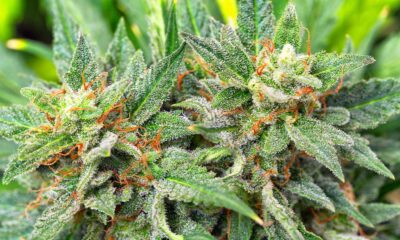Joint Opinions
The Plaintive Opposition: SAM
It may come as little surprise that certain prominent politicians have stepped forward in the wake of legalizing votes in Colorado and Washington to speak out against cannabis liberalization. But while the tired old rush to the cameras to try to shape public opinion has been a reliable and predictable staple of the long American drug policy debate, the content of their arguments may come as quite a shock. Hemmed in by public opinion overwhelmingly favoring reform, the drug warriors have resorted to making arguments which sound suspiciously… reasonable.
In the vanguard of this new prohibitionist brigade stand Patrick Kennedy and Kevin Sabet, with the occasional assist from their buddy David Frum. Now, I admire and respect all three of these men [but wouldn’t it be nice if these boys let a few girls into their club? Just sayin’]. So before I point out the flaws in their argument, let me first take a minute to celebrate what they get right:
- First and foremost, they realize that cannabis policy is a menu, not a light switch. The lock-’em-up vs. legalize dichotomy, which has dominated the debate since Allen Ginsberg began his head-on attacks of Anslinger-era prison sentences in 1964, has gone out of date. Today’s reform campaigns urge voters to “tax and regulate,” recognizing quite correctly that the word “legalize” specifies little in the form of affirmative policy. Kennedy and Sabet also want to move beyond the old binary argument and into the much more mature question of what is the most responsible cannabis policy for the 21st century US. If this marks the moment when all sides finally gave up the shouting matches of old, it shall be remembered as a great day.
- They recognize the failure of imprisonment as prevention. Although they conspicuously limit the declaration to users found with small amounts of pot (presumably, they feel differently about growers and dealers), Kennedy and Sabet admit that not much good comes out of the status quo of arrests and prosecutions. Instead, they argue for an alternative system which funnels offenders into “health interventions and other assistance” – and to the extent that some cannabis users do develop a problematic dependence (up to 10% of active users, a rate considerably lower than alcohol cocaine but still significant), their proposal makes sense.
- They suggest we start telling kids the truth about drugs. In addition to drug treatment, the new group also recommends “Science-based drug education for parents and kids [as] a top national priority.” This is an outstanding idea, long overdue. For decades, groups like DARE and the White House’s famous “Just Say No” education programs ran roughshod over the available scientific data, even while their colleagues at NIDA and the DEA were doing everything in their power to keep Americans ignorant of the true nature of cannabis. When kids grow into high schoolers and discover for themselves that the harms associated with weed were exaggerated by their teachers and other authority figures, it undermines the warnings from those same figures against more dangerous drugs like alcohol or heroin. Ultimately, education is the best preventive of abuse – but only if it’s honest.
Remedial Biology
But now we come to their argument’s flaws, which are significant. Perhaps their most glaring logical flop, given their commendable emphasis on science-based drug education, is their almost embarrassing ignorance of drug pharmacology. While they begin one point by correctly noting that many medical marijuana “patients” have received recommendations for ailments little more serious than minor aches or pains, they completely miss the scientific boat when they try to present a foil of “true” medical marijuana: the discredited drug Marinol. This pill, which they claim “contain[s] marijuana’s most active ingredient” (Marinol is synthetic THC suspended in sesame oil), has been all but driven from the market by its slew of alarming side effects and a slow absorption rate which makes precise dose titration difficult. To their credit, they also mention Sativex, a drug which is legal in 22 countries and has proven superior to Marinol by virtue of its fast-acting sublingual delivery and its chemical content of roughly equal doses of THC and CBD, creating a cannabinoid blend more closely resembling that of natural cannabis.
But it is their breezy analysis of dangerous opiate drugs which truly reveal Kennedy and Sabet’s limited grasp of pharmacology. Incredibly, they analogize to morphine: “Just like we don’t smoke opium to reap the benefits of morphine… we need not smoke marijuana to get its therapeutic properties.” Leaving aside for a moment the fact that electronic vaporizers which negate most or all of the harms of smoking are cheaply available domestically, this statement is absurd. Smoked tar opium, which these two solons find so intrinsically abhorrent, actually much less dangerous than morphine, both in its addictive potential and in the risk of fatal overdose. In fact, were it not for vestigial laws of a blatantly racist past, modern doctors may very well prefer tar opium (or more likely an alkaloid blend facsimile with standardized ratios) over pure morphine, which is only safe to administer in limited situations. It is in fact because of government regulations allowing supervised administration of morphine in hospital settings that the drug is now associated with safe and responsible use; back when the federal government simply criminalized morphine (especially in the 20s and 30s), it existed as a street drug which did far more damage to public health and caused much more crime than smoked opium did.
The reason for this is primarily pharmacological. Whereas isolated morphine, a powerful depressant, can cause rapid swings in the functioning of the central nervous system, the presence of nearly two dozen other opioids, like codeine, in the resin of the opium poppy moderates morphine’s effects by encouraging competition for access to receptor sites in the neural network. Thus it is less likely with smoked opium that any one alkaloid should wield too disproportionate an effect on the user.
But while this built-in safety mechanism – dubbed the “entourage effect” by scientists – may play a nifty trick with opium, it exists on a whole different level in cannabis resin, which contains over four hundred distinct organic compounds including over 80 “exocannabinoids”: constituents found nowhere in nature except in cannabis. If Kennedy and Sabet had their way and made pure-THC Marinol the gold standard of medical marijuana, US patients would miss out on CBD, which according to emerging science on the prevention of diseases like cancer and diabetes may actually be far more important than THC. And in so doing, they would destroy the built-in moderating effects of the cannabis plant, making “medical marijuana” more dangerous and less effective.
Old Prejudices Die Hard
Finally, Kennedy and Sabet fall victim to the same flaw of logic which so often characterizes the arguments of the drug warriors: bemoaning cannabis’ harms while scarcely considering its benefits. They mention ER visits from experimenters who’ve taken a (nonlethal) overdose, impaired driving, and the ill-understood connection between teen experimentation and lowered test scores. These are all legitimate concerns. But they’re peanuts compared to what the stakes could actually be.
Consider, for example, new evidence suggesting that regular cannabis use may significantly lower the user’s risk of obesity and diabetes. If indeed cannabinoids lower the risk of these two extremely costly conditions which already affect up to a third of Americans – and I caution that it is still too early to know for certain – then the benefits of increased marijuana use could easily outweigh the negative consequences Kennedy and Sabet mention. The connection between cannabis and cancer could be even more game-changing. While a small number of studies suggest a positive correlation between heavy cannabis use and elevated risk of cancer, the majority of the available evidence suggests just the opposite. Imagine a world in which everyone’s risk of developing cancer could be cheaply cut in half.
Would it make sense to throw that future away just because the drug which provided it came with some undesirable side effects (which, by the way, are nowhere near as bad as those of chemotherapy)? Finally, there is the (also ill-understood) substitution theory: if very many users choose to smoke marijuana instead of alcohol or other more dangerous drugs – and it’s apparent that at least some do – then the subsequent reduction of violent crime, drunk driving, and liver damage in the American population could easily be the biggest benefit of all.
As with so much else in cannabis policy, the answers to these questions remain uncertain; this reason, and not outdated prejudiced scare tactics against a relatively benign plant, is the most valid justification for moving carefully and thoughtfully into a new tax and regulate scheme. Because no modern state has ever fully legalized before, no one can accurately predict the outcome; but if regulators move gradually in ways designed to allow data collection from natural policy experiments, Americans may finally begin to fill in vital gaps in our knowledge so other states and countries will know the best way to proceed with reform. Of course, none of this will be possible unless the White House allows such natural policy experiments to take their course, without interference.
Learn More about Chairman Patrick Kennedy’s Sam: Smart Approaches to Marijuana project



























